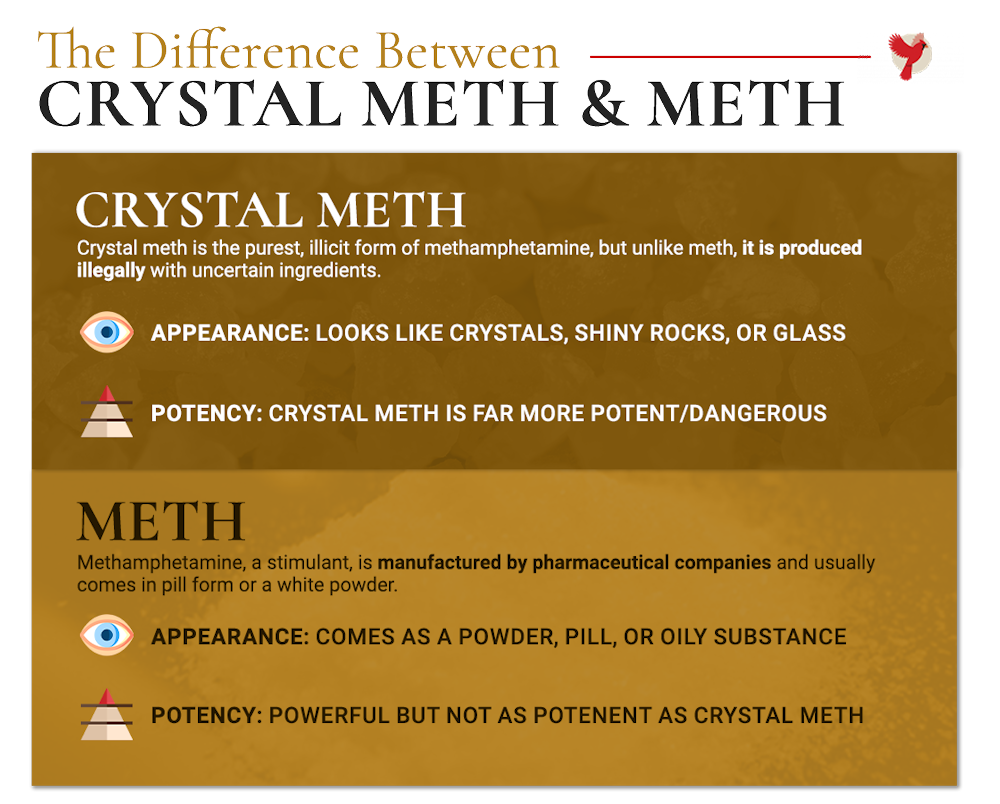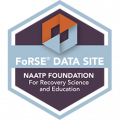You may hear some people use meth and crystal meth interchangeably, or you may have noticed that meth sometimes comes as a powder and other times as a rock or crystal. While both powder and crystal meth are the same substance, there are many differences between them. This is especially true when it comes to potency.
We will discuss the differences between crystal meth and regular meth, withdrawal symptoms, overdose symptoms, common treatment options for addiction, and more.

Crystal meth is a crystalline structure, as you can guess by the name. This type of meth is more solid and looks like crystals, shiny rocks, or even glass, depending on how refined it is.
It’s usually easy to tell the two apart based on appearance, but this isn’t always the case. For example, someone can grind up crystal meth into a powder. It’s typically shinier than regular meth, but this can make it hard to tell apart. In most cases, you can tell them apart by looking at them, but there are exceptions, of course.
Potency Differences
According to the National Institute on Drug Abuse, crystal meth is a distilled form of meth. While both are very powerful stimulants, crystal meth is far more potent than regular meth. Not only that, but the highs last much longer. Some people report feeling high for 24 hours, but that is typically in those who have a low tolerance or who use excessive amounts.
Due to the stronger potency, crystal meth may cause an overdose far quicker than regular meth. There is also a higher chance of becoming addicted. At the same time, both can cause overdose symptoms and other dangerous symptoms if used in high doses.
While crystal meth is more potent, both of these are chemically similar to amphetamine, which is commonly used to treat ADHD, sleep disorders, and other such concerns.
Meth Overdose Symptoms
The overdose symptoms are largely the same between crystal meth and regular meth. The most common overdose symptoms include:
- Difficulty breathing
- Symptoms of a heart attack, such as confusion and chest pains
- Seizures
- Blood pressure changes, either increased or reduced
- High temperature
- Dark urine or reduced urine
- Losing consciousness
- Extremely aggressive behavior
If you or someone else is experiencing these symptoms, then it would be best to seek immediate medical attention. The hospital will help to get the symptoms under control.

Meth Withdrawal Symptoms
In general, withdrawal symptoms occur when your body is trying to get back to normal functioning once the substance is gone. While it isn’t a rule, it’s commonly held that the effects of withdrawal are the opposite of the drug’s effects. This means that you might have low energy if you were using a stimulant.
The withdrawal symptoms are similar between regular meth and crystal meth. The most common withdrawal symptoms include:
- Anxiety and worry
- Sleepiness and fatigue
- Cravings
- Depression
- Increased appetite
- Visual or auditory hallucinations
- Delusions or strong and inflexible beliefs that are out of spectrum with reality
You might also be curious about when the withdrawal symptoms will strike and how long they last. The first 24 hours after your last dose tend to be the most severe at this time, and you might feel increased cravings.
While the first 24 hours are the hardest, you might continue to feel these symptoms for several days or weeks. If you are diligent about remaining sober, then the withdrawal symptoms will eventually subside. Connecting to recovery services can help during this time. Withdrawal symptoms tend to be worse with crystal meth because it is stronger, but the symptoms themselves are roughly the same.

Medical Detox
A medical detox program can be very beneficial in this regard. Unlike trying to detox from home by yourself, our medical detox program connects you with a doctor who is able to check your symptoms as you experience them. He or she will ensure that you get through this in the most comfortable way possible.
A medical detox typically involves:
- Tapering substances
- Prescribing medications to help ease withdrawal symptoms
- Providing further medical services if the symptoms become worse
- Ensuring your health throughout the entire process.
A detox program is able to help with the physical side of meth use and addiction, but it doesn’t help with the mental side of use. That’s why connecting to recovery services such as self-help groups and therapists can be so useful during this time.
Self-Help Groups
The two most common self-help groups are Alcoholics Anonymous and Narcotics Anonymous. These names are typically shortened to AA and NA. Many people who use meth gravitate towards NA because many people believe that meth is a narcotic, but this term really describes opioids and heroin use. At the same time, since you aren’t supposed to discuss the exact substance you used, many people try both AA and NA to find a group that they like.
We can help you find a group that resonates with you. Each group is different, but we know the area and how the local groups operate. Let us know what you’re looking for, and we’ll be able to find something that matches your needs.
Outpatient Care
The lowest level of care is called outpatient treatment or individual sessions. This is when you meet with your therapist, and both of you explore the issues that led to your drug use. You will learn about your stressors and healthier ways to cope with them. You can also explore other issues with your therapist so that you live a fuller and happier life.
The next level of care that still qualifies as outpatient treatment is known as intensive outpatient care, or IOP. IOP group therapy has you meet with a therapist and other recovery peers who are seeking recovery from their own substances.
IOP therapy allows you to learn from others while also getting more support in general. Unlike outpatient therapy that meets once a week, IOP meets three times a week, and each group session is three hours. This is a commitment, but it also ensures that you get the extra care you need while still maintaining your normal life.
Partial Hospitalization
A partial hospitalization program, or PHP, involves staying at the facility for about eight hours a day nearly every day of the week. This allows you to participate in recovery activities and to focus more on yourself. Many people find that their living environments are not conducive to recovery. This might involve stressors at home, people using in front of you, or other similar issues. PHP gives you a space to get away from that while improving your life.
Not only will you have more space, but you can also more easily access therapists, doctors, and others while you are at the facility. This makes it easy to get the help you need when you need it. Many people will leave PHP and drop down to IOP or outpatient care.
If you are curious about PHP, outpatient care, or other forms of treatment, then be sure to mention it when you contact us at First Recovery Center. We love when our clients are engaged in their recoveries and when they tell us what they need. We can also help if you’re not sure what you need. Our therapists and doctors can point you in the right direction.
Conclusion
If you’re worried that you’re using too much meth and want help, then contact us at First Recovery Center today, and we can provide you with the services you need. Our kind and caring staff are always on standby waiting for your call.

















